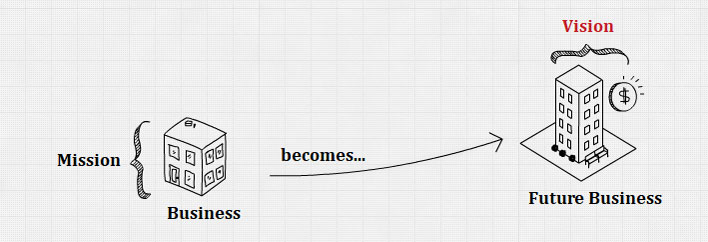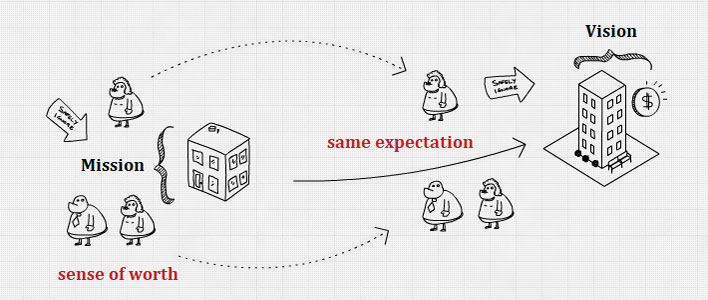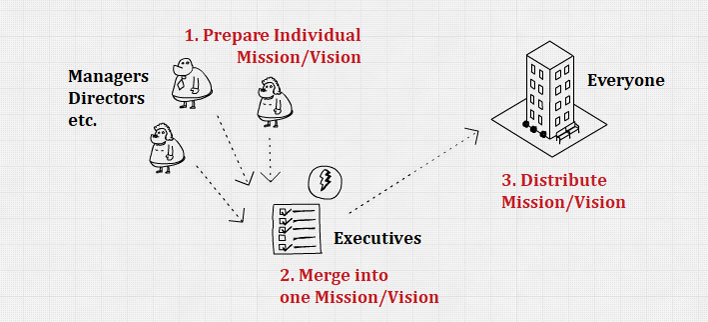Business Mission – What is Our Business?

A mission statement declares an organization’s reason for its existence.
All organizations have a reason for being. It reveals what an organization is and whom it wants to serve. It answers the pivotal question by stating what the company is providing to society.
A mission statement is essentially an enduring statement of purpose that distinguishes one organization from other similar enterprises.
A great mission statement defines the fundamental elements that set the organization apart from other firms, identify the domain of the organization’s operations in terms of products and services to be offered, and customers and market segments to be served.
A clear mission statement is essential for effectively establishing objectives and formulating strategies.
A business mission is a foundation for priorities, strategies, plans, and work assignments. It is the starting point for the design of managerial jobs and the design of managerial structures.
Firms that develop and systematically revisit their mission statements, treat them as living documents, and consider them to be an integral part of the firm’s culture realize great benefits.
Developing a mission statement is about analyzing the nature and scope of present operations and assessing the potential attractiveness of future markets and activities.
Business Vision – What Do We Want to Become?

A vision statement describes what an organization wants to become.
The vision statement should be short, preferably one sentence, and as many managers as possible should have input into developing the statement.
It is especially important for top executives in any organization to agree on the basic vision that the firm strives to achieve in the long term.
Developing a vision statement is often considered the first step in strategic planning, sometimes preceding even the development of a mission statement.
Benefits of Vision and Mission

They provide managers with a unity of direction that transcends individual, parochial, and transitory needs.
Developing a comprehensive vision and mission statement reveals and resolves divergent views among managers. Setting a vision and mission is a genuine decision that can create controversy. And a genuine decision must be based on divergent views to have a chance to be a right and effective decision.
Individuals who have worked together for a long time and who think they know each other suddenly may realize that they are in fundamental disagreement. Negotiation, compromise, and eventual agreement on company vision and mission are needed before people can focus on more specific strategy formulation activities.
They promote a sense of shared expectations among all levels and generations of employees, across individuals and interest groups.
Developing a business vision and mission is a big step toward management effectiveness. This is always a choice between alternatives, each of which rests on different assumptions regarding the reality of the business and its environment.
A change in vision and mission may lead to changes in objectives, strategies, organization, and behavior. Hidden or half-understood disagreements on the definition of a business vision and mission underlie many of the personality problems, communication problems, and irritations that tend to divide the organization.
Considerable disagreement among an organization’s interest groups over vision and mission statements can cause trouble if not resolved.
They project a sense of worth and intent that can be identified and assimilated by company outsiders.
All organizations need customers, employees, and managers, and most firms need creditors, suppliers, and distributors. The vision and mission statements are effective vehicles for communicating with important internal and external stakeholders.
An organization that fails to develop a vision statement, as well as a comprehensive and inspiring mission statement, loses the opportunity to present itself favorably to existing and potential stakeholders.
Characteristics of a Mission Statement

A mission statement should not be too lengthy.
The recommended length is less than 250 words. An effective mission statement should arouse positive feelings and emotions about an organization. It should be inspiring in the sense that it motivates readers to action.
A mission statement is broad in scope. There are 2 reasons for this characteristic.
First, a good mission statement allows for the generation and consideration of a range of feasible alternative objectives and strategies without unduly stifling management creativity. Excess specificity would limit the potential of creative growth for the organization. However, an overly general statement that does not exclude any strategy alternatives could be dysfunctional. The fine balance between specificity and generality is difficult to achieve, but it is well worth the effort.
Second, a mission statement needs to be broad to reconcile differences effectively among, and appeal to, an organization’s diverse stakeholders. All stakeholders’ claims on an organization cannot be pursued with equal emphasis. A good mission statement indicates the relative attention that an organization will devote to meeting the claims of various stakeholders.
Stakeholders are the individuals and groups of individuals who have a special stake or claim on the company, including employees, managers, stockholders, boards of directors, customers, suppliers, distributors, creditors, governments, unions, competitors, environmental groups, and the general public.
A mission statement attracts customers who give meaning to an organization.
It is the customer who determines what a business is. It is the customer alone whose willingness to pay for a good or service converts economic resources into wealth and things into goods. What the customer thinks he/she is buying, what he/she considers value, determines what a business is, what it produces, and whether it will prosper. The customer is the foundation of a business and keeps it in existence.
A mission statement describes an organization’s purpose, customers, products or services, markets, philosophy, and basic technology.
In general, it should reflect the anticipations of customers. Rather than developing a product and then trying to find a market, the operating philosophy of organizations should be to identify customers’ needs and then provide a product or service to fulfill those needs.
A mission statement is often the most visible part of the strategic management process, and it should provide useful criteria for selecting among alternative strategies.
A clear mission statement provides a basis for generating and screening strategic options. The statement of mission should be dynamic in orientation, allowing judgments about the most promising growth directions and those considered less promising.
It reflects judgments about future growth directions and strategies that are based on forward-looking external and internal analyses.
A mission statement generates the impression that a firm is successful, has direction, and is worthy of time, support, and investment from all socioeconomic groups of people.
It should include the 4 following components: (1) Philosophy: what are the basic beliefs, values, aspirations, and ethical priorities of the firm? (2) Customers: who are the firm’s customers? (3) Markets: where does the firm compete geographically? (4) Products or services: what are the firm’s major products or services?
The Process of Developing Vision and Mission Statements

First, firms select several articles about mission and vision statements and ask all managers to read these as background information.
Second, firms ask managers themselves to prepare a vision and mission statement for the organization.
Third, a facilitator or committee of top managers should then merge these statements into a single document and distribute the draft statements to all managers.
A request for modifications, additions, and deletions is needed next, along with a meeting to revise the document. To the extent that all managers have input into and support the final documents, organizations can more easily obtain managers’ support for environment scanning, strategy formulation, implementation, evaluation, and control activities.
During the process of developing vision and mission statements, some organizations use discussion groups of managers to develop and modify existing statements.
Some organizations hire an outside consultant or facilitator to manage the process and help draft the language. Sometimes an outside person with expertise in developing such statements, who has unbiased views, can manage the process more effectively than an internal group or committee of managers.
Fourth, decisions on how best to communicate the vision and mission to all managers, employees, and external constituencies of an organization are needed when the documents are in final form.
Some organizations even develop a videotape to explain the statements, and how they were developed.
In multidivisional organizations, management should ensure that divisional units perform strategic management tasks, including the development of a statement of vision and mission. Each division should involve its own managers and employees in developing a vision and mission statement that is consistent with and supportive of the corporate mission.
Resources
Further Reading
- Mission Statement Definition (investopedia.com)
- Mission Statement Definition (entrepreneur.com)
- What is a Company Mission and How Can You Create Your Own? (tinypulse.com)
- Mission and Vision Statements (bain.com)
- Company Vision and Mission Statement Examples (blog.hubspot.com)
- Mission and Vision Statement Examples to Follow (oberlo.com)
- Why Your Mission and Vision Statements Don’t Work (forbes.com)
Related Concepts
References
- Hitt, M. A., Ireland, D. R., & Hoskisson, R. E. (2016). Strategic Management: Concepts: Competitiveness and Globalization (12th ed.). Cengage Learning.
- Hitt, M. A., Ireland, D. R., & Hoskisson, R. E. (2019). Strategic Management: Concepts and Cases: Competitiveness and Globalization (MindTap Course List) (13th ed.). Cengage Learning.
- Hill, C. W. L., & Jones, G. R. (2011). Essentials of Strategic Management (Available Titles CourseMate) (3rd ed.). Cengage Learning.
- Mastering Strategic Management. (2016, January 18). Open Textbooks for Hong Kong.
- Wheelen, T. L. (2021). Strategic Management and Business Policy: Toward Global Sustainability 13th (thirteenth) edition Text Only. Prentice Hall.